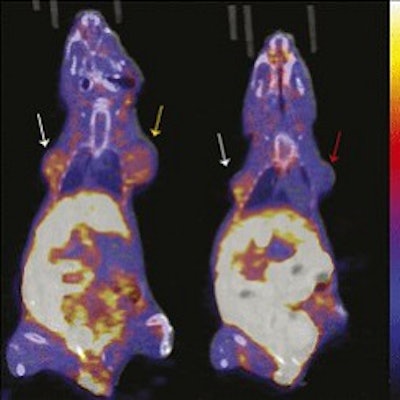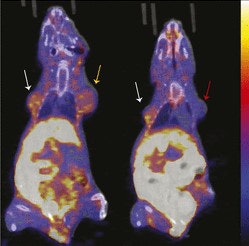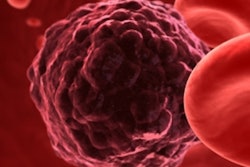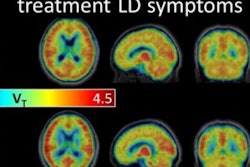
PET imaging with fluoro furanyl norprogesterone (FFNP) could provide a new option for measuring changes in progesterone receptor (PR) levels due to estrogen treatment for breast cancer, according to a study published in the February issue of the Journal of Nuclear Medicine.
The challenge for clinicians is that many hormone therapies interfere with estrogen's ability to regulate the expression of PR protein, which is more pronounced in the presence of estrogen.
"Typically, anatomic size and proliferation biomarkers are analyzed to determine endocrine sensitivity," explained study co-author Dr. Amy Fowler, PhD, from the radiology department at the University of Wisconsin-Madison in a statement from the Society of Nuclear Medicine and Molecular Imaging (SNMMI). "However, noninvasive detection of changes in PR expression with FFNP during an estradiol challenge may be an earlier indicator of the effectiveness of a specific hormone therapy."
 PET images show uptake of FFNP in tumor xenografts expressing PR-A or PR-B in mice. Representative coronal F-18 FFNP PET/CT images of MDA-MB-231 (red arrow), 231 PR-A (white arrows), and 231 PR-B (yellow arrow) tumor xenografts (19 days after implantation) from 12 mice imaged one hour after injection. Physiologic uptake from hepatobiliary clearance is also visualized. Images courtesy of Salem et al and JNM.
PET images show uptake of FFNP in tumor xenografts expressing PR-A or PR-B in mice. Representative coronal F-18 FFNP PET/CT images of MDA-MB-231 (red arrow), 231 PR-A (white arrows), and 231 PR-B (yellow arrow) tumor xenografts (19 days after implantation) from 12 mice imaged one hour after injection. Physiologic uptake from hepatobiliary clearance is also visualized. Images courtesy of Salem et al and JNM.For the study, the researchers administered estrogen treatment to increase PR expression in T47D human breast cancer cells, which had estrogen and progesterone receptors but no human epidermal growth factor receptor 2. Estrogen was also given to mice bearing T47D tumor xenografts.
The cells and mice were imaged with F-18 FFNP, while assays were conducted for cell uptake and tissue biodistribution. To investigate the separate role of PR-A and PR-B isoforms on overall F-18 FFNP binding, triple-negative MDA-MB-231 breast cancer cells were engineered to express either PR-A or PR-B (JNM, February 2019, Vol. 60:2, pp. 220-226).
In T47D cells treated with estrogen, the researchers observed an increase in FFNP uptake 48 hours after treatment. FFNP uptake in mice with T47D tumor xenografts was seen 48 and 72 hours after treatment. This increase also correlated with an increase in PR protein expression and proliferation. There was no significant preferential FFNP binding or uptake by PR-A versus PR-B in PR isoform cell lines or tumor xenografts.
"This is an important finding given the variability of PR isoform expression observed in breast cancer patients," Fowler said. "Validation of PR imaging as a biomarker of endocrine sensitivity in patients before and after estradiol challenge could provide new opportunities in the field of molecular imaging and nuclear medicine for breast cancer imaging."



















